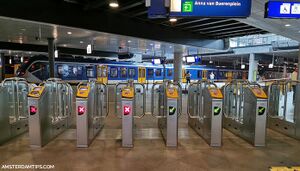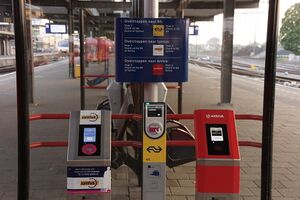Netherlands/Arrival
Arriving in the Netherlands
When you have just arrived, you may not yet know how to get around, or how to obtain basic resources. Regardless of what visa you choose, you'll need a lot of the same things to start out. Here are some important things that might help.
Cell phones
Until you have a residence permit, you will only be able to obtain prepaid service with a physical SIM card. To get connectivity quickly, you have a few decent options:
- Lebara offers a tourist prepaid SIM that can be bought with cash. It can be activated any time within about 90 days of purchase. This is a good option for when you have just arrived, and you can get it by going into a cell phone repair shop that advertises Lebara service. In most city centers this will not be hard to find. If you struggle, try going to the shop of a major service provider, like Odido or KPN, and simply asking where you can buy a Lebara SIM. The downside is that Lebara's network coverage is not top tier.
- KPN offers prepaid service, but you need to buy minutes, SMS, and data in discrete packages, and the pricing is not so good. However, if you anticipate getting your residence permit quickly, you might choose this, just because it is then extremely easy to convert to a post-paid "normal" account when you have your residence, and KPN network coverage is the best.
In any case, Dutch cell phone providers must let you take your phone number with you if you change your service. As long as you keep your service paid for, you shouldn't have to change numbers, even if you move between providers or service types. If someone tries to change it anyway, tell them no.
Dialing phone numbers
You may see Dutch phone numbers written with a 0 in front, a 6 in the front, or +31 in the front.
- Starts with 0: from a Dutch phone, you can dial it exactly as it is written. From any phone, you can dial +31, skip the 0, and dial the rest.
- Starts with a 6: from a Dutch phone, you can dial 0, then the whole number as it is written, starting with the 6. From a foreign phone, dial +31, then the 6 and then the rest of the number.
- Starts with +31: from any phone, you can dial this number exactly as it is written. From a Dutch phone, you can drop off the +31 and start with 0 instead.
Public Transit
The Netherlands is surprisingly accessible by public transport (openbaar vervoer or OV). Most places, even in remote villages, are walking distance from a bus stop, and trains run often and efficiently. Google Maps keeps up to date with most public transport schedules, and the website/app 9292.nl collects timetables for all the providers.
Paying for public transit
There are several ways to pay for public transport in the Netherlands:
- Acquire an anonymous or personalized public transport card, called an OV-chipkaart, and manage its credit balance at a kiosk or online.
- Use your bank card directly (or use an NFC digital wallet like Apple Pay or Google Wallet).
- Purchase a paper chip ticket at the station/bus/terminal.
- Purchase a ticket online and use your phone's app to show a QR code.
- Purchase a(n international) ticket online and receive a paper ticket with QR barcode.



Note that many buses and trams will not accept paper money, and some do not accept payment on board at all. It's best to purchase an OV-chipkaart or ticket at the station or terminal beforehand.
All train and metro stations will have card readers in the station, sometimes combined with barriers to prevent access unless you scan your card. Smaller stations may only have a reader on the platform. Buses tend to have the card readers inside and require you to check in with your card when you board and check out before you disembark.
Transferring between transit owned by the same company, for example between trains both operated by NS, usually doesn't require checking in and out. Switching between transit operators or switching between types of transit often requires checking out and then checking in again (e.g. from a metro to a bus). For the high-speed train line from Amsterdam to Schiphol and Rotterdam requires a supplement payment for the trip. This "toeslag" can be added by the extra chipcard post on the platform. Most trains do not require this extra fee and it's marked clearly on the departures board if the train you are taking requires it.
The trip fare is based on how far you traveled, i.e. where you checked in and out with your OV card; this makes it hard to predict your fare. Purchasing an OV-chipkaart with around €50 and checking usage is probably best. If your balance becomes too low, you won't be able to board transit until you fill it up, as the system enforces certain rules (buses require 4€ on the OV-chipkaart, while NS requires 20€!).
Proving you've paid
A train conductor or bus security may ask to see your OV card and tap it to see that you're checked in. If you get on the train and realize you forgot to check in, you can use the NS app or website to quickly buy a ticket (whoops!). This can be used to show the conductor your ticket digitally, and you can use this ticket to exit the station.
Personalized chipcards
Personalized chipcards, as opposed to anonymous ones, can be used to purchase reduced fare tickets and other extras. This requires a photo (does not have to be a passport photo, just a recent one) and a name, though the card will only display first and middle initial and last name. The name should match your ID.
OV-fiets
You can also use your chipcard to rent an OV-fiets, which is one of the blue-and-yellow public bicycles you'll see in cities. You will need a personalized OV-chipkaart and a free OV-fiets ticket.
Driving
While an international driver's license isn't required, it is good to have. The EU has different categories of driver's licenses than the US and this can cause trouble depending on the situation. The AAA offers international driver's licenses by showing up in-person or by mail.
American driver's licenses are valid for 185 days after moving to the Netherlands. If you have the 30% tax ruling, you can easily transfer your driver's license, but make sure you do it within the 185 day limit. If you don't qualify for the 30% ruling, you will have to take driving lessons and do both a written and practical test. These can be done in English for an extra fee. However, the rules for driving in the Netherlands are quite different than the US, so it's best to pick up a practice book.
Banking
Once you have registered at the city hall, you will receive a citizen service number (burgerservicenummer or BSN). A BSN is similar to a social security number. A BSN is necessary to get a Dutch bank account. The largest banks in the Netherlands are ABN AMRO, ING, and Rabobank; there are also eco-friendly banks like ASN and Triodos (although these communicate solely in Dutch).
A Dutch PIN card is the best way to pay for things. Many places do not accept cash, and some that also don't accept credit cards. In particular, the popular grocery store Albert Heijn does not allow paying with credit cards (which includes Visa or Mastercard debit cards!), so be sure to go to a checkout lane that accepts cash -- or go to a different grocery store!
Be aware that (travelers) checks are not accepted in the Netherlands! The last bank stopped accepting them in 2021.
Groceries and Supplies
Stores are most likely to be open Monday through Saturday until 6pm, except supermarkets until 8-10pm (depending on the chain and location). In the biggest cities (Amsterdam, Utrecht, Rotterdam, The Hague) stores are open seven days a week. But elsewhere in the Netherlands, Sunday is a quiet day and many stores tend to be closed. Some municipalities/cities will have monthly shopping Sundays ("koopzondag") as well as weekly shopping nights ("koopavond") when some stores are allowed to stay open longer until 9PM, either on Thursday (mostly bigger university cities) or Friday. There are some, more religious, municipalities that have rules around which shops can be open on Sundays and shopping nights, but most larger municipalities/cities tend to allow shops to decided for themselves. Most supermarket chains are open but just close sooner in the evening (often 7pm). If you find yourself in small towns or the countryside, you should plan ahead for the weekend and make sure you have enough to eat and such.
Many shops also open late or not at all on Mondays (or only open after noon). This is a way of making sure shop owners and retail workers can access things like doctors and banking that are not open at the weekend, which is pretty nice!
Also check the section about banking -- it can be hard to pay for things without a PIN card from a Dutch bank, and you should carry some cash if you don't have one. Credit cards tend to only be accepted in tourist centers or at restaurants. Cash is still accepted most places unless explicitly indicated with signage.
Accidents and Emergencies
Our national emergency dialing code is 112. Use this, or ask someone to call for you, if you are in a dangerous situation and need emergency services right away.
If you need medical attention right away, but are not in need of an ambulance (something like a painful ear infection or an animal bite) you can call a spoedhulp huisartsenpost. This is like a general urgent care clinic. If it's something they can't handle, they will send you to the hospital emergency department.
Emergency medical costs
Not as bad as the USA! You may end up being billed a few hundred euros if you need to be seen right away at the hospital and you don't have any insurance yet.
About the police
Dutch police (politie) usually show up promptly when they are called, and are trained much better than American police at de-escalation, conflict resolution, and public safety. With that said, there are certainly issues of uneven enforcement sometimes, often based on race or social class. However, in general, if you need to call the police, doing that will not put you or someone else in danger of your lives.
(If you are from the US, it may reassure you to know that ANY use of a firearm by a police officer is automatically investigated by the national police, and it can and does lead to the officer being prosecuted when there is abusive behavior.)
Many municipalities also have a community law enforcement group (handhaving.) These are not police, but they are related to the law enforcement system -- they don't carry weapons, and can issue fines and tickets, but cannot make arrests. They deal with things like public nuisances and civic order (think of parking tickets, trash in the wrong places, etc) but can also give you advice if you're lost or having a problem. A lot of people get irritated with the handhaving, because their main job is to enforce all the little annoying stuff that keeps public life orderly, and sometimes it seems like they are doing it just because they can... but they can actually give you helpful advice if you need it.
There's also the military police (Koninklijke Marechausee) who you'll encounter when you go through a border control, or if there is a matter of national security. They are usually heavily armed and wear berets. They're pretty easy to spot, and the ones at the airport checkpoints at least always seem professional and polite.